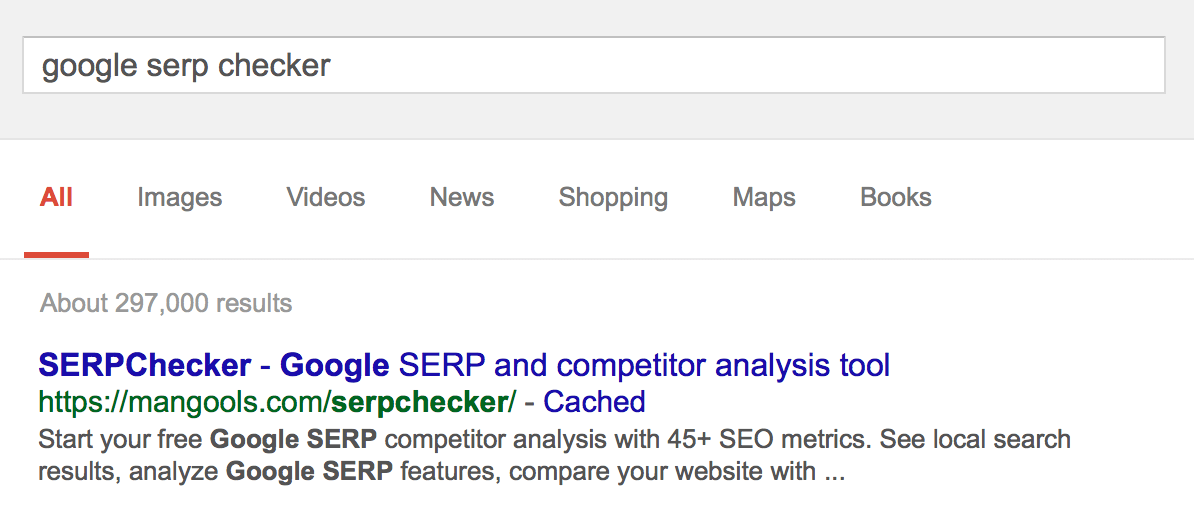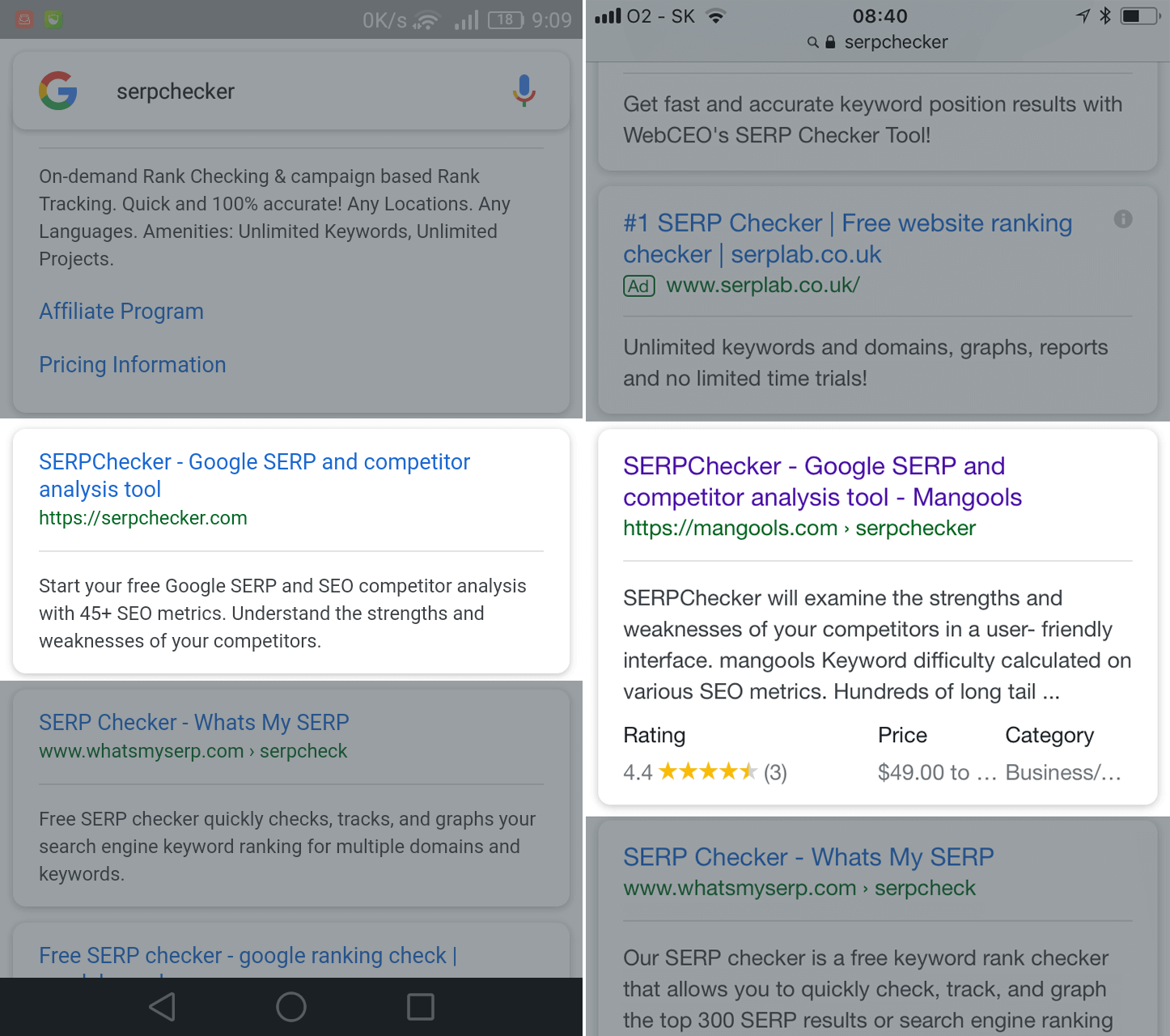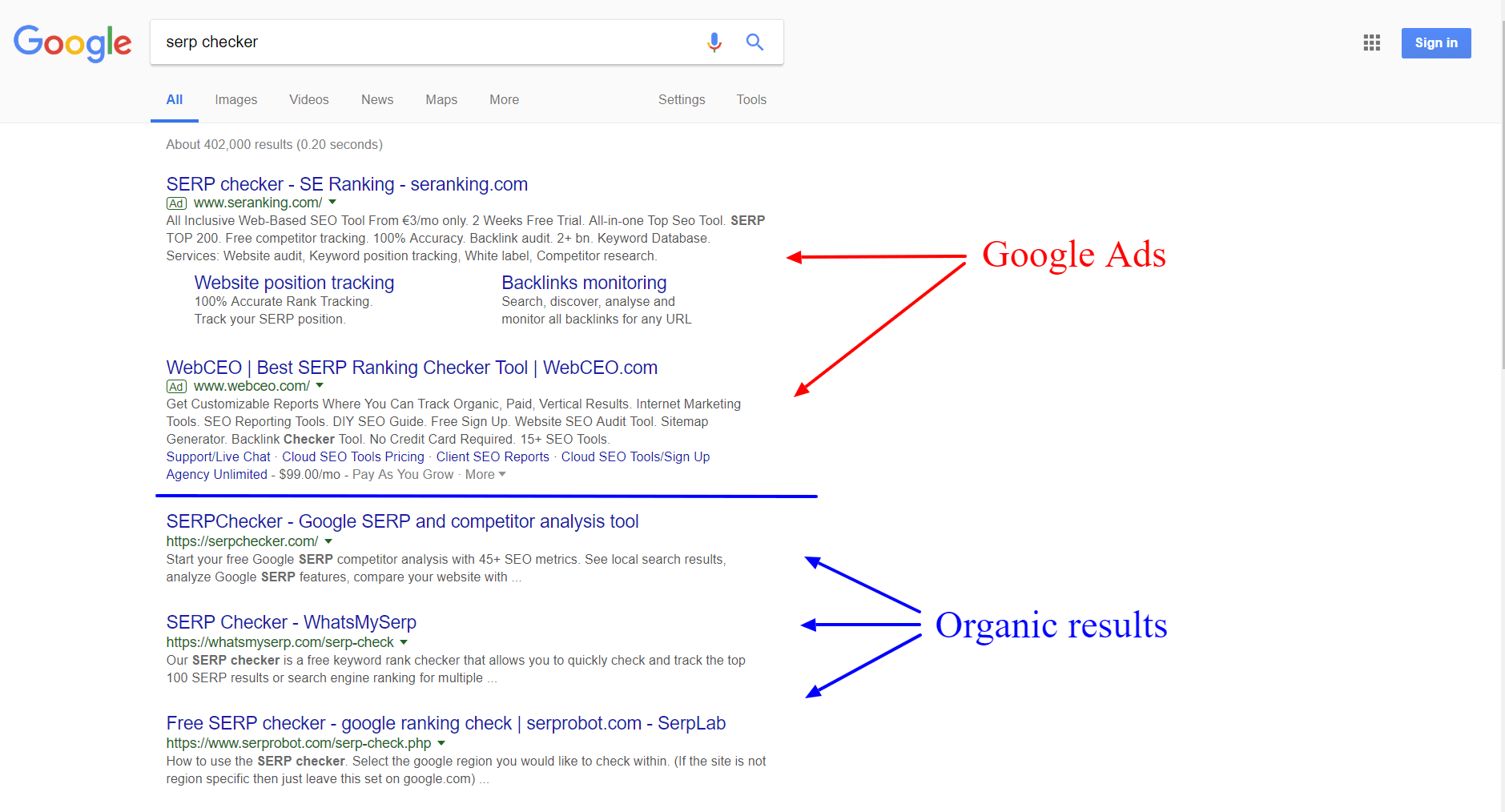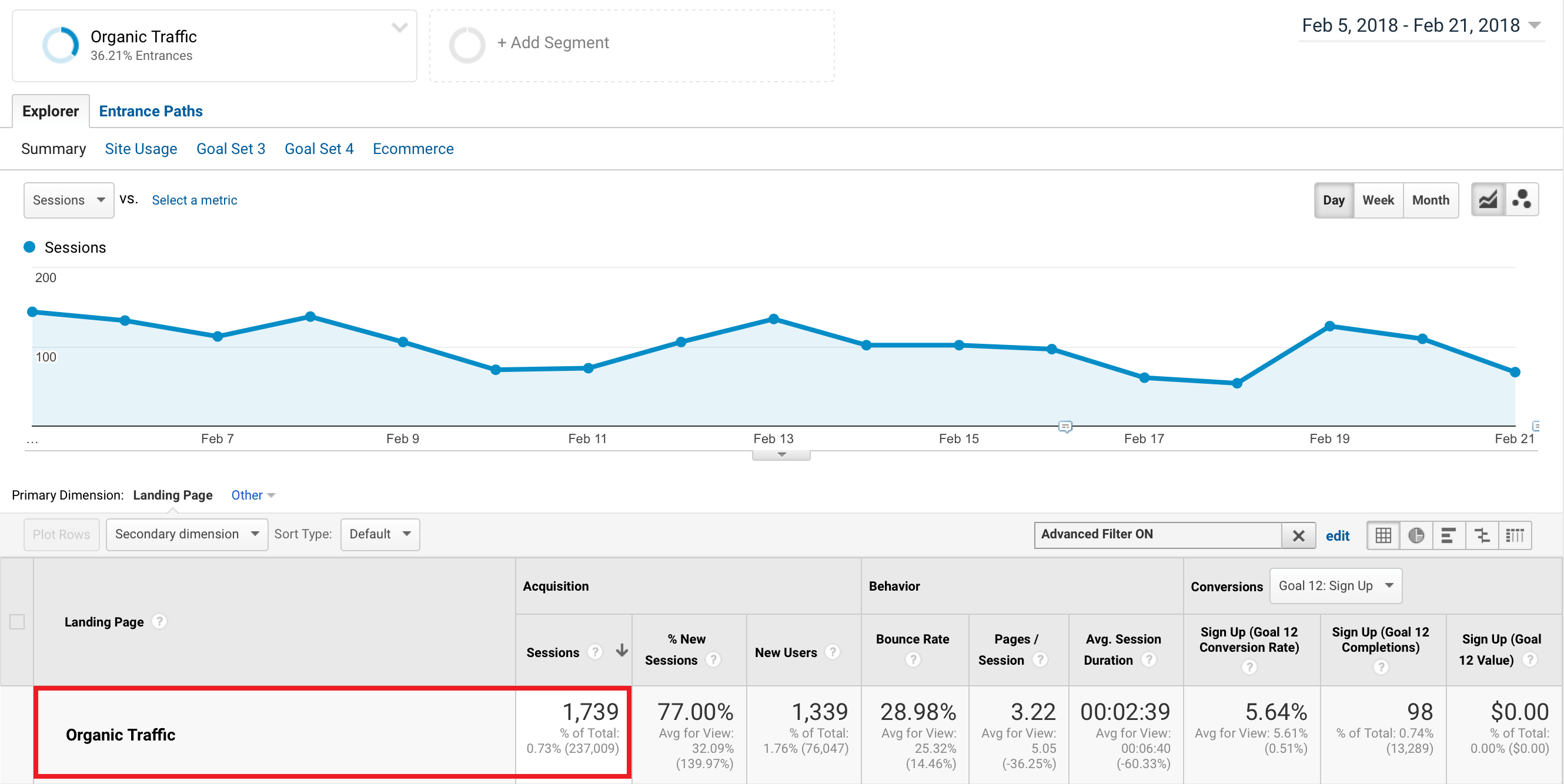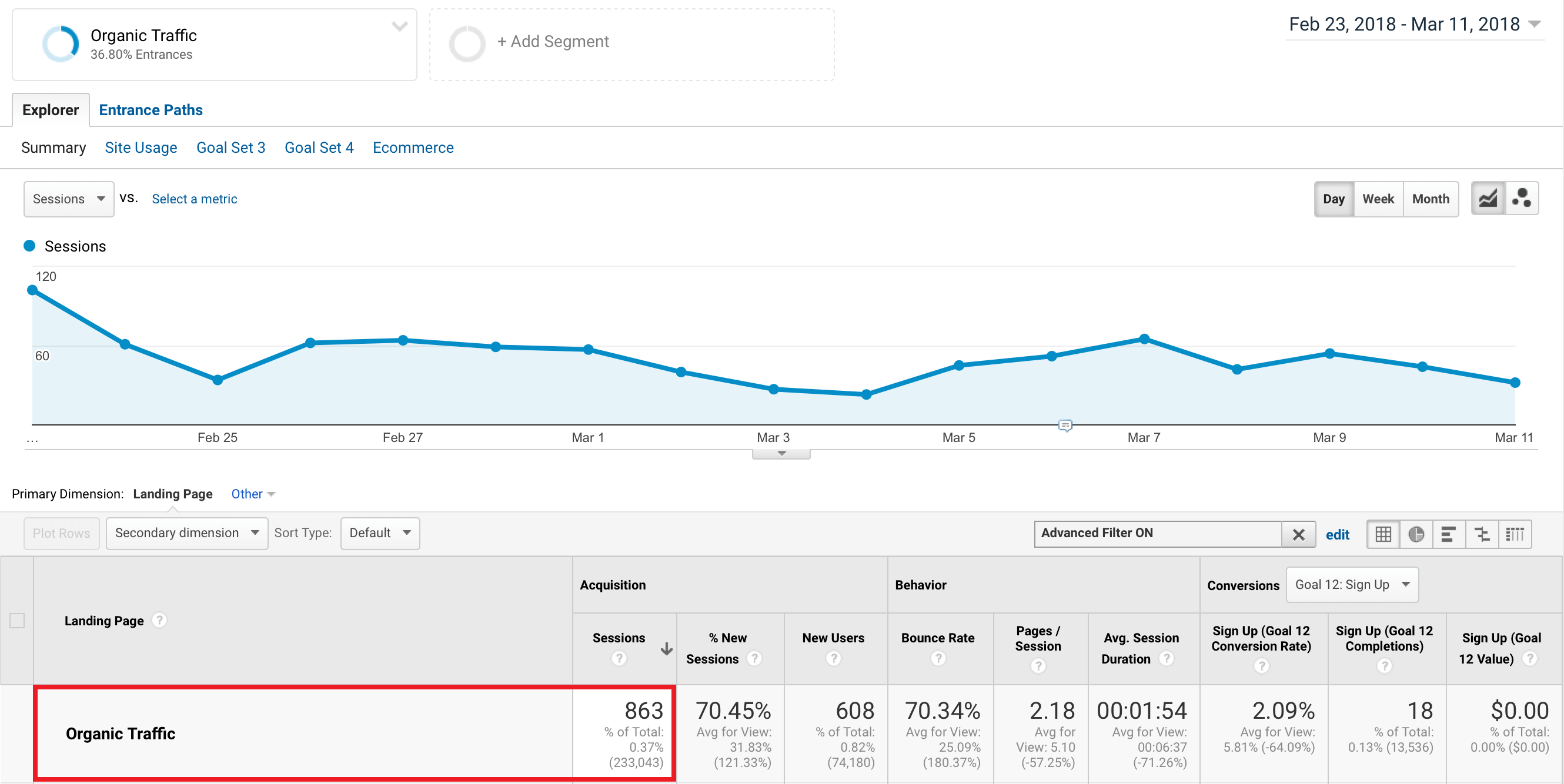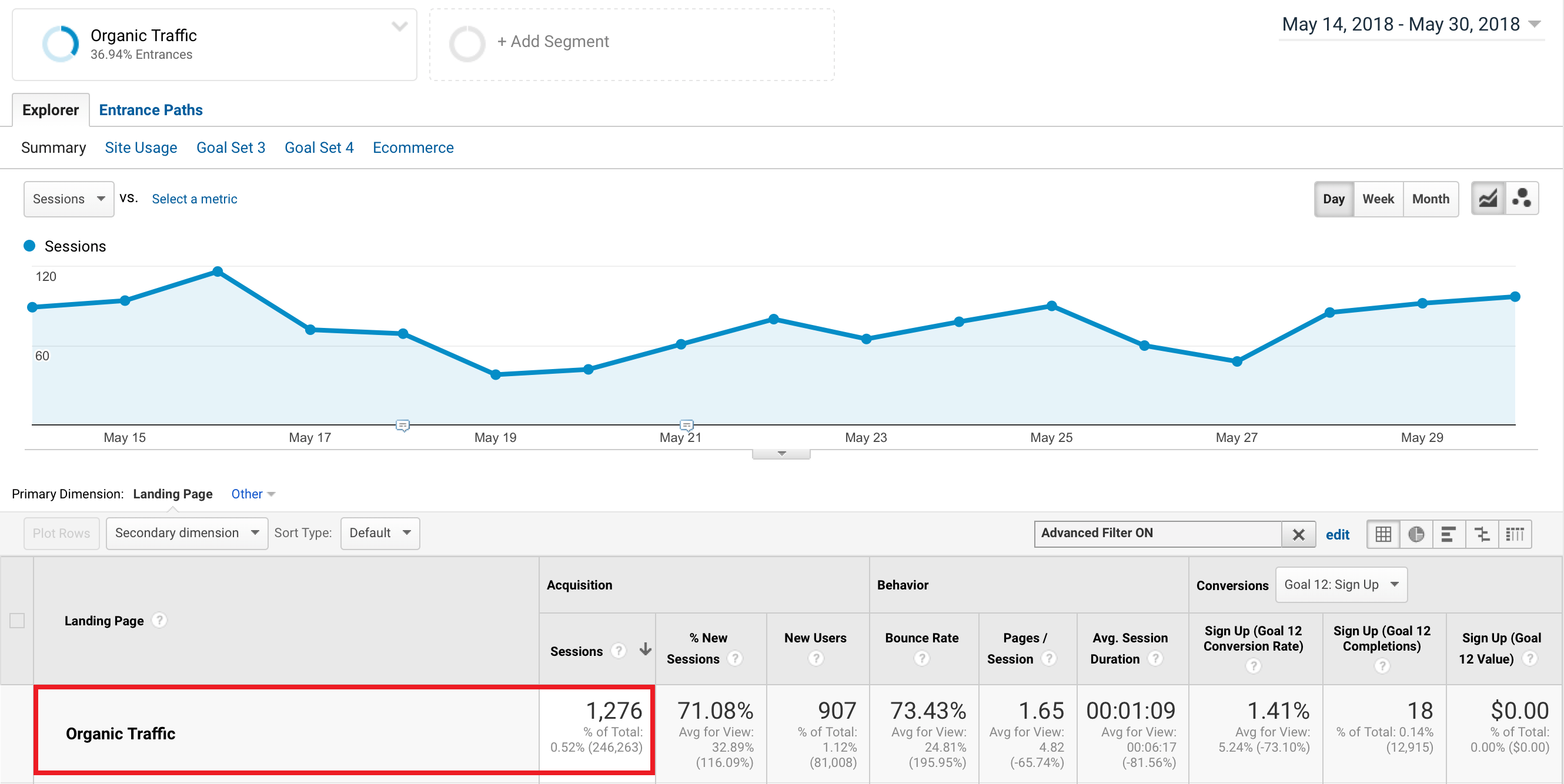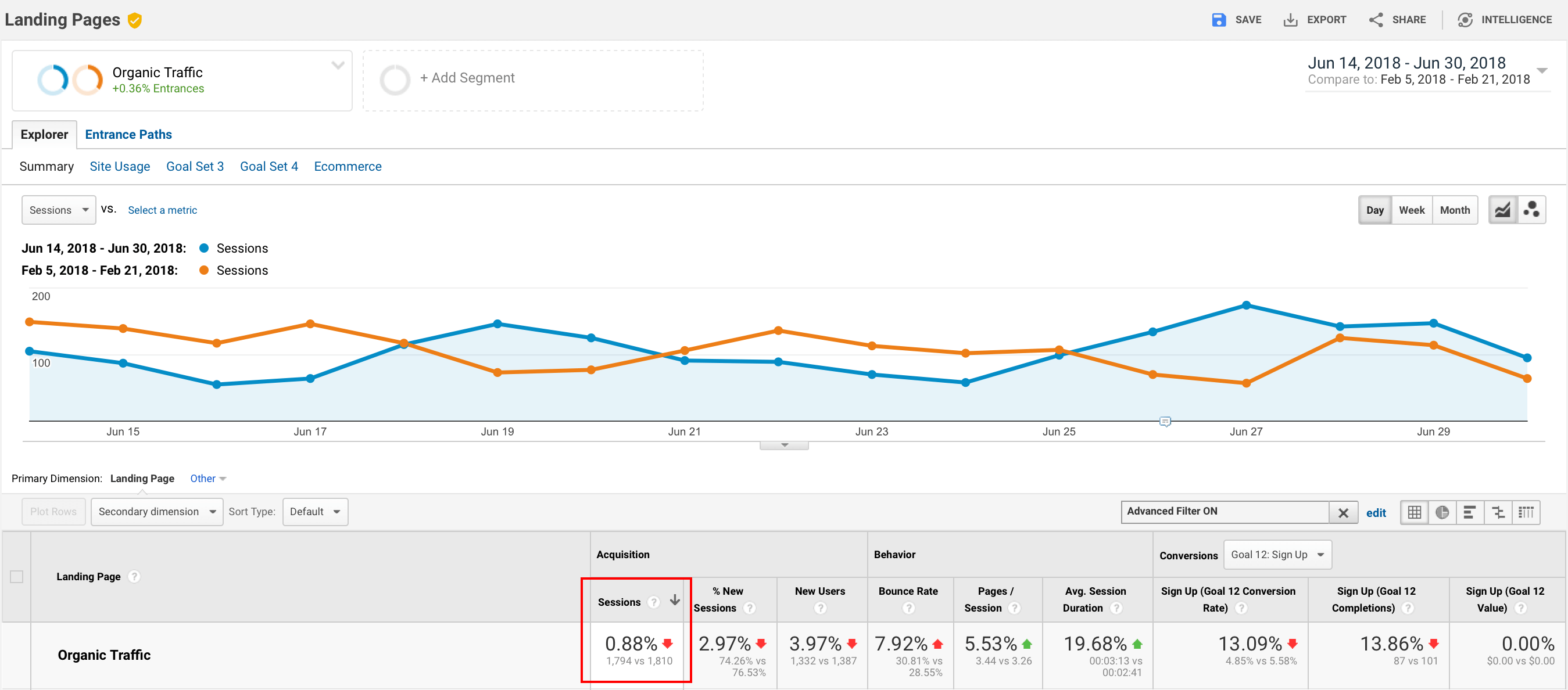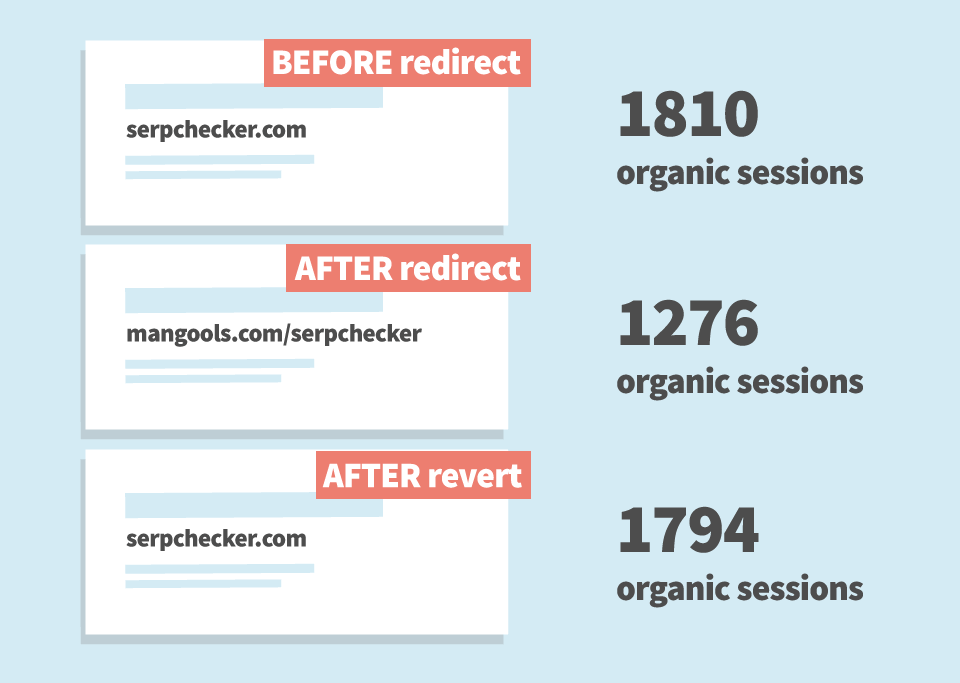At the beginning of 2018, after we launched our 4th tool, we had many discussions about how to increase the synergy of our tools in terms of SEO.
Our philosophy of having highly focused tools, all on separate landing pages, hasn’t changed. However, we wanted to boost their SEO potential by migrating them to one domain: mangools.com.
And that’s exactly what this 301 redirect case study is about. Let me tease you a bit: This is not the usual success story of 301 redirect!
Table of contents:
- Challenge
- Data and time background
- Original website
- Checklist
- Results of the redirect
- CTR
- Organic traffic
- Investigation continues
- Reverting back
- Results of the revert
- What did we learn?
Challenge
Mangools as a brand has covered all our tools for more than 2 years. It would be a logical step to migrate them on mangools.com while keeping in mind that we don’t want to create all-in-one tool. Mangools is a package of SEO tools.
On the other hand, building authority and quality link profile for a new domain every time we launch a new tool isn’t much effective. It would also bring additional possibilities when targeting topical keywords.
That’s why we decided to migrate the domains to one and we chose serpchecker.com to test the outcome.
Pros:
- mangools.com can benefit from backlinks and domain authority of our other domains (kwfinder.com, serpchecker.com, serpwatcher.com, linkminer.com)
- Huge time savings when doing outreach and link building – instead of doing the same thing 4, 5, 6, … times
- Easier branding of Mangools as a package of SEO tools
- Ability to display rich snippets: star rating, pricing, product category
Cons:
- kwfinder.com is the strongest domain so mangools.com can be affected positively, while the other one might suffer temporarily
- Short-term organic traffic drops but that’s obvious when doing 301 redirect
- A slightly different appearance of the tools in the SERP than returning users are used to
Data and time background
This case study is based on the following time period: February 2018 – June 2018, mainly on these 5 periods:
- Before redirect: February 5 to February 21
- After redirect 1: February 23 – March 11
- After redirect 2: April 2 – April 18
- Before revert: May 14 – May 30
- After revert: Jun 14 – Jun 30
The findings are based on the data from:
- Google Analytics
- Google Search Console
- SERPWatcher
- SERPChecker
- KWFinder
- Google Search
- Google AdWords
Original website
Here’s the deal: serpchecker.com has been online since summer 2016. Most of the time, it’s been considered as an add-on to KWFinder. The tool itself and its features are designed for an in-depth SERP analysis.
At the time of doing the 301 redirect, there were 4 subpages. The original SERP snippet of serpchecker.com:
These are the numbers before the redirect
This is the total number of sessions vs. organic sessions “Before redirect” (February 5 to February 21):
The numbers are based on the “Landing Page” report from Google Analytics.
I picked 10 keywords and their average positions, CTR and the number of organic clicks they generated from February 5 to February 21.
I’ve selected both branded and non-branded terms with various rankings, CTR and organic clicks to cover as many circumstances as possible.
Before redirect: February 5 – February 21
| Keyword | Avg. position |
Avg. CTR |
Organic clicks |
| serp checker | 6.4 | 16.19% | 537 |
| serpchecker | 1.6 | 54.98% | 149 |
| serp check | 3.8 | 18.37% | 104 |
| google serp checker | 10.1 | 11.23% | 84 |
| check serp | 4.4 | 14.22% | 61 |
| serp analysis | 3.3 | 14.76% | 53 |
| free serp checker | 4.7 | 4.53% | 16 |
| serp checker tool | 2.6 | 2.81% | 7 |
| serps checker | 8.4 | 5.79% | 26 |
| serp analysis free tool | 2.1 | 40.00% | 10 |
* based on the data from Google Search Console
Checklist
We read a lot of guides and case studies to eliminate all possible mistakes. We even discussed our plans with a well-known local SEO agency here in Bratislava.
These were the tasks:
- Write down a list of pages that will be redirected
- Make a list of internal links that will be changed
- Make a list of external links we can change: our tools on different domains, the Mangools website, blog, social profiles
- Set and deploy the redirects
The structure of new landing pages was easy. We moved the website and its subpages to mangools.com:
| Old | New |
| serpchecker.com/ | mangools.com/serpchecker/ |
| serpchecker.com/features/ | mangools.com/serpchecker/features |
| serpchecker.com/features/seo-competitor-analysis-tool/ | mangools.com/serpchecker/features/seo-competitor-analysis-tool/ |
Results of the redirect
We deployed the changes on February 21, 2018, around 3 pm UTC/GMT +1. It was a beautiful winter day and we were eager to see the updates indexed by Google. Some of us could see the updated search results after 24 hours!
You can imagine the situation: the whole team staring at keyword rankings in Search Console, SERPWatcher and Google search.
Hooray! This is it:
The 1st evaluation of rankings
After 2 or 3 days, the keyword rankings looked really good. I compared these 2 time frames:
- Before redirect: February 5 – February 21
- After redirect 1: February 23 – March 11
| Keyword | Avg. position Before redirect |
Avg. position After redirect 1 |
Change |
| serp checker | 6.4 | 4.6 | ⬆ 1.8 |
| serpchecker | 1.6 | 1.4 | ⬆ 0.2 |
| serp check | 3.8 | 4.3 | ⬇ 0.5 |
| google serp checker | 10.1 | 14.7 | ⬇ 4.6 |
| check serp | 4.4 | 5.8 | ⬇ 1.4 |
| serp analysis | 3.3 | 2.9 | ⬆ 0.4 |
| free serp checker | 4.7 | 6.8 | ⬇ 2.1 |
| serp checker tool | 2.6 | 6.5 | ⬇ 3.9 |
| serps checker | 8.4 | 6.5 | ⬆ 1.9 |
| serp analysis free tool | 2.1 | 2.0 | ⬆ 0.1 |
* based on the data from Google Search Console
The average position change:
The rankings decreased by 0.81 positions in average. The positive value represents lower rank while the negative value is a higher rank.
The weighted average position change (weight = avg. monthly search volume):
The rankings decreased by 0.24 positions in average.
* The search volumes are based on the data from KWFinder
When we look at the numbers, during the first 17 days after the redirect, it went pretty good.
The 2nd evaluation of rankings
We decided to wait a bit before analyzing the results again. Well, no, we didn’t. We were doing it almost every day but for the purpose of this case study, I included the selected time frames because we made some changes in structured data (will be explained below).
Moreover, the Easter holidays took place, the website traffic was low, so the results wouldn’t be comparable.
The 2nd evaluation is based on these 2 time periods:
- Before redirect: February 5 – February 21
- After redirect 2: April 2 – April 18
| Keyword | Avg. position Before redirect |
Avg. position After redirect 2 |
Change |
| serp checker | 6.4 | 3.6 | ⬆ 2.8 |
| serpchecker | 1.6 | 2.1 | ⬇ 0.5 |
| serp check | 3.8 | 4.5 | ⬇ 0.7 |
| google serp checker | 10.1 | 6.3 | ⬆ 3.8 |
| check serp | 4.4 | 4.6 | ⬇ 0.2 |
| serp analysis | 3.3 | 2.5 | ⬆ 0.8 |
| free serp checker | 4.7 | 6.2 | ⬇ 1.5 |
| serp checker tool | 2.6 | 3.6 | ⬇ 1.0 |
| serps checker | 8.4 | 3.9 | ⬆ 4.5 |
| serp analysis free tool | 2.1 | 2.3 | ⬇ 0.2 |
* based on the data from Google Search Console
The average position change:
The rankings increased by 0.78 positions in average. The positive value represents lower rank while the negative value stands for higher rank.
The weighted average position change (weight = avg. monthly search volume):
The rankings increased by 1.44 positions in average.
* The search volumes are based on the data from KWFinder
A few weeks after the redirect, the rankings increased! But we all know that SEO and rank tracking is not only about ranking #1.
CTR
Almost identical average keyword positions just a few days after the redirect and increased positions 6 weeks later? That sounds great, doesn’t it? Now it’s time to analyze the engagement.
Here we go! This is the part where the tables have turned.
Let’s compare the average CTR of our 10 keywords in the first 2 tracking periods:
- Before redirect: February 5 – February 21
- After redirect 1: February 23 – March 11
| Keyword | Search Volume |
Avg. CTR Before redirect |
Avg. CTR After redirect 1 |
Change |
| serp checker | 5,378 | 16.19% | 6.56% | -59.48% |
| serpchecker | 212 | 54.98% | 21.12% | -61.59% |
| serp check | 1,557 | 18.37% | 5.71% | -68.92% |
| google serp checker | 1,300 | 11.23% | 3.62% | -67.76% |
| check serp | 5,400 | 14.22% | 4.17% | -70.68% |
| serp analysis | 316 | 14.76% | 11.24% | -23.85% |
| free serp checker | 477 | 4.53% | 4.44% | -1.99% |
| serp checker tool | 393 | 2.81% | 2,36% | -16.01% |
| serps checker | 1,555 | 5.79% | 2.46% | -57.51% |
| serp analysis free tool | 20 | 40.00% | 38.10% | -4.75% |
* based on the data from Google Search Console and KWFinder
The CTR of all the tracked keywords dropped. And as you can see, the drop was brutal. We started losing a lot of organic traffic.
It wasn’t only about the 10 keywords. I took a look at all search queries in the Search Console.
Before redirect: February 5 – February 21
After redirect 1: February 23 – March 11
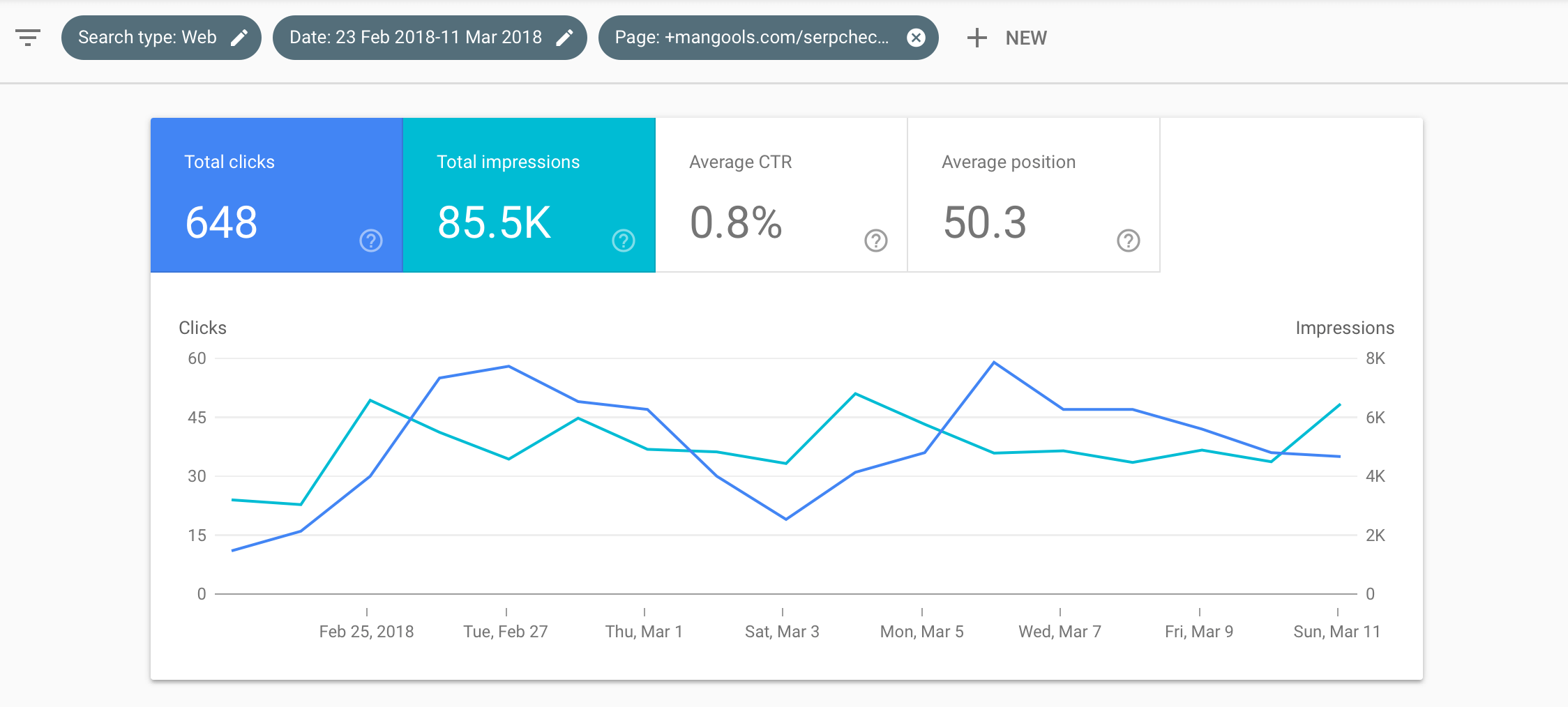
Property: mangools.com, so I have to add the “page” filter to display results related to redirected SERPChecker pages
85.5K impressions generated less than a half of the clicks compared to 68.9K impressions. The overall CTR dropped from 2.5% to 0.8%.
Potential reasons behind lower CTR
Right after we saw the numbers, we started investigating. The CTR is mainly influenced by the positions and appearance of the website in Google search. It includes the title tag, meta description, site links, URL and rich snippets.
- Higher rankings after the redirect led to lower CTR in many cases. So it wasn’t about the positions.
- Title tag was identical or with “- Mangools” at the end depending on the search query.
- serpchecker.com didn’t have site links, neither did mangools.com/serpchecker.
- The URL was obviously different.
- More and more sponsored links were targeted on the keywords serpchecker.com ranked for
- Google doesn’t display rich snippets on homepages so they started to appear for mangools.com/serpchecker immediately: star rating, price and category.
Actions we took:
The only 2 reasonable arguments seemed to be the rich snippets and sponsored links (ads). We didn’t expect the change of the URL would affect the CTR that much.
We inspected many different SERPs of competitive tools and other SaaS businesses and came to a conclusion that the star rating may indicate a review or a blog post instead of a product landing page.
Adiós, rich snippets!
We disabled the rich snippets and couldn’t wait to see the results. Here are the numbers:
- Before redirect: February 5 – February 21
- After redirect 2: April 2 – April 18
| Keyword | Search Volume |
Avg. CTR Before redirect |
Avg. CTR After redirect 2 |
Change |
| serp checker | 5,378 | 16.19% | 9,15% | -43,48% |
| serpchecker | 212 | 54.98% | 25,54% | -53,55% |
| serp check | 1,557 | 18.37% | 7,40% | -59,72% |
| google serp checker | 1,300 | 11.23% | 6,51% | -42,03% |
| check serp | 5,400 | 14.22% | 6,11% | -57,03% |
| serp analysis | 316 | 14.76% | 14,74% | -0,14% |
| free serp checker | 477 | 4.53% | 1,04% | -77,04% |
| serp checker tool | 393 | 2.81% | 1,81% | -35,59% |
| serps checker | 1,555 | 5.79% | 1,80% | -68,91% |
| serp analysis free tool | 20 | 40.00% | 27,50% | -31,25% |
* based on the data from Google Search Console and KWFinder
Before redirect: February 5 – February 21
After redirect 1: February 23 – March 11
After redirect 2: April 2 – April 18
Although the CTRs “After redirect 2” have increased when compared to the “After redirect 1”, they remained insanely low compared to the “Before redirect” values before the 301 redirect.
Since the number of impressions increased to 106K, the number of total clicks got a bit higher. Yet again, the CTR was only 1%.
How about launching Google Ads?
Another thing that came to our mind was trying Google Ads. One of those coincidences that happen once in a lifetime, occurred when we were redirecting serpchecker.com to mangools.com/serpchecker.
Many of our competitors started bidding on keywords that serpchecker.com ranked for. One of the probable reasons is that Ahrefs launched their new tool called SERP Checker. As they are one of the biggest players on the market, the others didn’t want to stay behind.
But the thing with the ads is a bit more complicated in the “SERP checker” market. The organic search results for this keyword and its related terms are full of tools that are actually rank tracking tools. And the ads are basically the same.
For a very long time, serpchecker.com was the only SERP analysis tool on the 1st page. We noticed the SERP Checker by Ahrefs on the 1st page in March.
To push the CTR and test new possibilities, we temporarily launched ads targeted on the most important keywords:
- serp checker
- serpchecker
- serps checker
- check serp
- serp checker tool
- google serp checker
You know what’s funny? The Google algorithm is probably used to search results that are rank trackers. The ad relevance (to the landing page) according to AdWords for the majority of the targeted keywords was above the average. However, the quality score was only 3/10 in most cases.
The campaign was online for more than a month from April to June. The average CTR was only 3,41%.
Organic traffic
Of course, lower organic CTR leads to lower organic traffic. That’s where things usually get serious.
Before redirect: February 5 – February 21
After redirect 1: February 23 – March 11
After redirect 2: April 2 – April 18
When I compared the “Before redirect” to “After redirect 1”, there was a 50% organic traffic drop.
The “After redirect 2” (after we disabled the rich snippets) generated 32% more organic traffic than the “After redirect 1”. But still, it was a 34,6% organic traffic drop compared to the “Before redirect”.
Investigation continues
The question is: What happened? From the technical point of view, everything was ok. Keyword rankings were slightly better and there were more organic impressions. We reviewed the list of potential reasons once again:
Higher rankings after the redirect led to lower CTR in many cases. So it wasn’t about the positions.Title tag was identical or with “- Mangools” at the end depending on the search query.serpchecker.com didn’t have site links, neither did mangools.com/serpchecker.- The URL was obviously different.
- More and more sponsored links were targeted on the keywords serpchecker.com ranked for.
Google doesn’t display rich snippets on homepages so they started to appear for mangools.com/serpchecker immediately: star rating, price and category.
When I go back to the Google Ads – the most probable reason behind lower CTRs and organic traffic (at least we thought so) – it seems the numbers are reasonable.
But is it true that 2-3 sponsored links stole the 30% of CTR? According to the Advanced Web Ranking CTR study, it looks like it may be true.
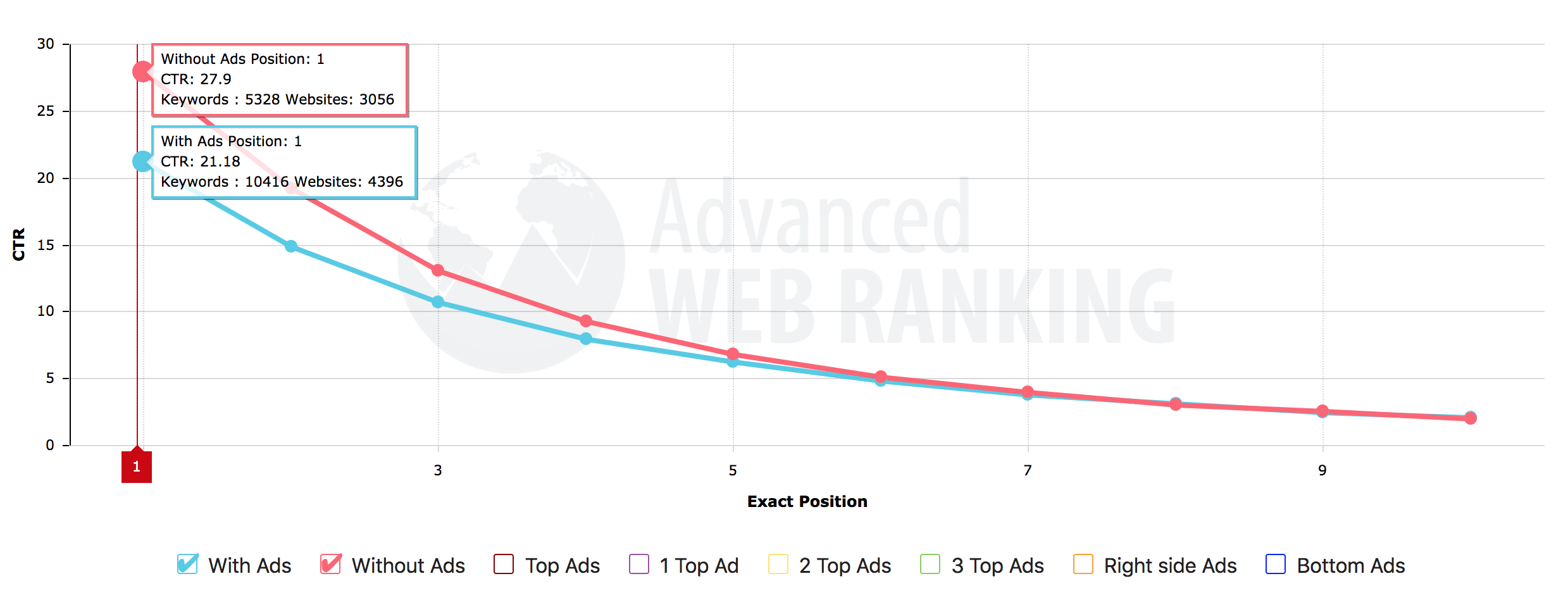
This chart shows the organic CTRs for searches that contain ads vs. searches that do not contain ads
The CTR for the position #1 without ads is 31,7% higher than with ads.
I’ve checked the positions #2 and #3 and the numbers were almost identical: 29,4% for #2 and 22,2% for #3. The difference decreases immensely in lower positions.
Given the numbers, we decided to continue with the tracking of the results. In case nothing changed or if we didn’t find another reason, we would be forced to reconsider our SEO and branding plans.
Reverting back
After more than 3 months, the organic traffic remained 27% lower, despite the keyword rankings were higher.
Before revert: May 14 – May 30
We were 90% sure the main reason is Google Ads. Yet there still might have been an unknown reason we haven’t detected and some of us even started to think that the drop was caused by the changed URL.
That is why we decided to revert everything to test this hypothesis. We got back to the checklist and deployed everything as it was in February. We did this on June 12, 2018, around 5 pm UTC/GMT +2. It was raining outside.
Results of the revert
These are the tracking periods I will focus on:
- Before redirect: February 5 to February 21
- After redirect 2: April 2 – April 18
- After revert: Jun 14 – Jun 30
The “After revert” follows the same measuring pattern as previous time frames to keep the same conditions.
Keyword rankings
| Keyword | Search Volume | Avg. position Before redirect |
Avg. position After redirect 2 |
Avg. position After revert |
| serp checker | 5,378 | 6.4 | 3.6 | 2.4 |
| serpchecker | 212 | 1.6 | 2.1 | 1.2 |
| serp check | 1,557 | 3.8 | 4.5 | 3.1 |
| google serp checker | 1,300 | 10.1 | 6.3 | 4.0 |
| check serp | 5,400 | 4.4 | 4.6 | 3.5 |
| serp analysis | 316 | 3.3 | 2.5 | 3.4 |
| free serp checker | 477 | 4.7 | 6.2 | 5.2 |
| serp checker tool | 393 | 2.6 | 3.6 | 1.8 |
| serps checker | 1,555 | 8.4 | 3.9 | 3.2 |
| serp analysis free tool | 20 | 2.1 | 2.3 | 2.4 |
* based on the data from Google Search Console and KWFinder
The majority of the organic positions for the keywords with the highest search volumes got back or even improved 2 days after the revert.
CTRs
| Keyword | Search Volume |
Avg. CTR Before redirect |
Avg. CTR After redirect 2 |
Avg. CTR After revert |
| serp checker | 5,378 | 16.19% | 9,15% | 16.94% |
| serpchecker | 212 | 54.98% | 25,54% | 42.79% |
| serp check | 1,557 | 18.37% | 7,40% | 18.07% |
| google serp checker | 1,300 | 11.23% | 6,51% | 4.89% |
| check serp | 5,400 | 14.22% | 6,11% | 15.97% |
| serp analysis | 316 | 14.76% | 14,74% | 18.18% |
| free serp checker | 477 | 4.53% | 1,04% | 2.08% |
| serp checker tool | 393 | 2.81% | 1,81% | 0.68% |
| serps checker | 1,555 | 5.79% | 1,80% | 1.35% |
| serp analysis free tool | 20 | 40.00% | 27,50% | 53.85% |
* based on the data from Google Search Console and KWFinder
The CTRs followed the same trend. Some of them even improved for the keywords with the highest search volumes.
Organic traffic
And here’s the comparison of the organic traffic “Before redirect” and “After revert”.
The current appearance of serpchecker.com in the organic search results is almost identical as it was in February. Below is the comparison of all 3 Google search snippets.
Before redirect:
After redirect:
After revert:
The only difference between the NEW and REVERTED is the URL:
The latest results from SERPWatcher
I also took a look at our tracking in SERPWatcher to compare the results before the redirect and after the revert. Below is the screenshot of the Dominance Index, a metric we have developed to calculate the organic traffic share based on the tracked keywords, their positions and search volumes.
The index reached values from 20 to 26 before we decided to do the redirect. Right after the revert, it was 26. Nowadays, the metric oscillates around 40. It’s because the keywords with the highest search volumes improved their positions. In most of the cases, it was from the top 5 to #1.
Of course, this could happen with the positions if the website would stay redirected. But given the CTRs from the “redirected” time period, can you imagine how many organic clicks we would lose?
What did we learn?
Believe it or not, we are still not 100% sure why the CTR dropped so dramatically after the redirect.
We thought it was caused by the presence of the ads but as we can see, the CTR got back to normal after the revert even though the ads remained the same.
So the only logical explanation (from the known possible reasons) is that the CTR drop was caused by the change of the URL.
Although, it was the least expected reason, it kind of makes sense if you think about it. SEO is no longer only a technical stuff. UX and psychological factors influence the engagement in many ways that cannot be measured exactly.
On the other hand, this 301 redirect case study doesn’t fully explain why the CTR dropped for all non-branded keywords too. If any reason comes to your mind, don’t hesitate to let us know!
Key takeaways:
- Website migration, no matter how well executed, is a huge change and you can’t be 100% sure what will be the result.
- Make sure to have historical data for all keywords, rankings, CTRs and the overall organic traffic before you start the website migration so you can detect possible issues.
- Timing is important, 301 redirect should be done during the off-peak period and when it comes to products, start with the ones that won’t dramatically hurt your revenue in case something goes wrong.
- The CTR for branded terms may drop if they are a part of the original domain, so think wisely.






